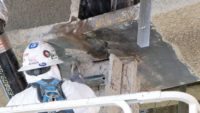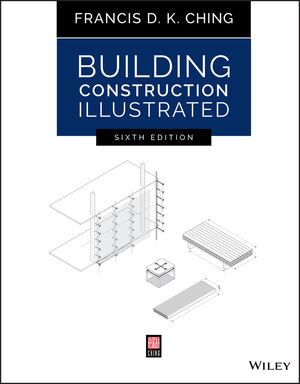Attendees of a recent presentation on the earthquake-resistant structure of San Francisco’s Salesforce Transit Center—intended to provide a safe haven when the Big One hits—lauded the engineering of the 4.5-block-long hollow tube that supports the 1.2-million-sq-ft “groundscraper.” But there also was much talk of the project’s black eye, as a consequence of brittle fractures of the bottom flanges of two bridge-like built-up plate girders that span 87 ft over Fremont Street.
“It’s such a shame about the girders; it’s such a beautiful structure overall,” said one engineer, who declined to be named, after Bruce Gibbons, a managing principal of the hub’s engineer-of-record, Thornton Tomasetti (TT), presented at the American Institute of Steel Construction’s 2019 NASCC: The Steel Conference. The April 3-5 event drew more than 5,100 registrants to St. Louis.
A brouhaha over the blame for the girder fractures that shuttered the three-story transit hub last Sept. 25, six weeks after it opened, is just one dispute marring the project. There is another. Last Oct. 16, the general contractor, the Webcor/Obayashi Joint Venture, filed suit in the Superior Court of California against the public owner, the Transbay Joint Powers Authority, alleging breach of contract and seeking more than $150 million in extras to its $994,517,600 contract (ENR 10/29/18 p. 11). On Feb. 22, TJPA filed a cross-complaint. And on March 15, WO filed a complaint against seven subcontractors, including the steel sub Skanska USA Civil West California District and the girder fabricator, the Herrick Corp.
TJPA alleges WO breached its preconstruction services obligations by failing to provide accurate estimates, ensure competitive bidding and rebid packages at no cost to TJPA. The authority also claims WO breached its construction services obligations by failing to enforce Buy America requirements; misusing the request for information (RFI) process; submitting late, inaccurate and incomplete submittals; installing nonconforming work; staffing the project with inexperienced personnel; and failing to perform its close-out obligations in a timely manner.
The breaches resulted in “substantial additional costs” to TJPA and delayed the substantial and final completion of the project, says the complaint.
The complaints do not specifically relate to the girder fractures, but a future claim is likely over that responsibility. The third-floor girders support a rooftop park and hang the second-floor bus level, via a tension plate that thickens the web’s midspan and slots through the bottom flange.
Though the girders met all specifications and passed all inspections, TJPA’s investigator, forensic metallurgist LPI, blamed the fabricator for the fractures.
The root cause is failure to grind and polish 2 in. x 4 in. cuts where hanger plates slot through the bottom flanges, said LPI. The failure to grind, in combination with very brittle plate material at the mid-depth of the 4-in.-thick flange and service loads, created the fractures.
Thermal cutting caused expected microcracks. Shrinkage stresses from butt welds of the flange plate ends at the midspan enlarged the cracks. Stress from service loads turned the cracks into fractures.
The unraveling appears to have begun with a TT note for a “missing weld access hole” in the web. TT added the WAH to an approved-as-noted shop drawing. In an RFI, Skanska’s detailer questioned the WAH in the web and suggested holes in the bottom flange, which TT approved as WAHs. Revised shop drawings show cuts, not WAHs, in the bottom flanges.
TT declined to comment until the TJPA investigation is complete. Herrick and Skanska deny blame (ENR 4/1-8 p. 14). “Engineers know the quality of material is not consistent through the depth of the plate,” said Bob Hazleton, Herrick’s president. And he maintains the investigation is not focusing enough on the hanger slot, which is not a defined hole in the code.
The girder failures have rekindled discussions about potential pitfalls of connection design and detailing practices, especially for more complicated structures. Engineers are pressed for time, which can result in incomplete drawings. Shop drawing review is typically relegated to junior engineers. “It might be beneficial to flag certain conditions for special review,” said another engineer at the conference, who declined to be named.
Gregory P. Luth, president of the engineer that bears his name, said, “It makes no sense from a quality and safety point of view that the connection design and building design be done by different engineers.”
Further, for the transit hub’s several structural steel systems and many steel fabricators, Skanska hired one steel detailer—Candraft—a practice discouraged by the AISC Code of Standard Practice.
AISC says when fabrication and erection documents are not prepared by the fabricator, “the fabricator shall not be responsible for the completeness, coordination, or accuracy of fabrication and erection documents so furnished, nor for the general fit-up of the members that are fabricated from them. … The contract documents should be very clear as to the managing of this process,” advises the code, in the related commentary section.
“Normally, we don’t work for someone else who is doing the shop drawings," said Hazleton. "We normally communicate directly with the engineer and detailer about missing design details and shop practices."
However, on large projects such as the transit center, a single detailer provides consistency across multiple fabrication teams, he added.
Skanska said its rationale for hiring a single detailer was to ensure continuity and accuracy. “Candraft was provided each fabricator’s shop fabrication and detailing standards … and there was access between Candraft and the fabricators to clarify any open issues,” said Michael Iacovella, a Skanska vice president of communications.
WO held meetings twice a week with Skanska, TT, Candraft and, when needed, the fabricators “to provide opportunities to discuss the work, ask questions and obtain clarifications,” he added.
Still, something went awry. Luth argues, “Designing critical structures by committee makes no more sense than having two people drive a car at the same time: ‘I’ll steer and you brake.’ ”









